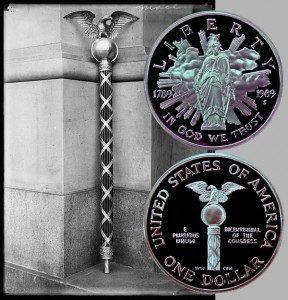Today, the Congress Commemorative Silver Dollar Coin remembers the decisions of 226 years ago in the first session of the House of Representatives.
On April 14, 1789, the members of the House of Representatives agreed as follows:
“Resolved, That it is the opinion of this committee, that the rules and orders following ought to be established, as additional standing rules and orders of this House, to wit:
A Sergeant-at-Arms shall be appointed, to hold his office during the pleasure of the House, whose duty it shall be to attend the House during its sitting, to execute the commands of the House from time to time, and all such process, issued by authority thereof, as shall be directed to him by the Speaker.
A proper symbol of office shall be provided for the Sergeant-at-Arms, of such form and device as the Speaker shall direct, which shall be borne by the Sergeant when in the execution of his office.
The fees of the Sergeant-at-Arms shall be, for every arrest, the sum of two dollars, for each day’s custody and releasement, one dollar; and for travelling expenses, going and returning, one-tenth of a dollar per mile.”
=====
Published in 1908, Henry Colford Gauss described the office of the Sergeant at Arms in his book, The American Government, Organization and Officials, With the Duties and Powers of Federal Office Holders; an Original Summarization:
=====
The Sergeant at Arms of the House of Representatives is required to maintain order in the House under the direction of the Speaker, and is the custodian, as the badge of his office, of the mace of the House, the symbol of the Speaker’s authority.
He is charged with removing all persons who may create disturbances and if the members of the House refuse to come to order at the call of the Speaker, the latter may call upon the Sergeant at Arms, who thereupon takes the mace from its position at the Speaker’s desk and proceeds to the scene of the disturbance upon the door of the House.
Should the presence of the symbol of authority fail to restore order, he has power, under the direction of the Speaker, to exercise such force by himself and his assistants as may be necessary to restore such order, even to the point of ejecting a member from the floor.
Such a contingency, however, is not expected to arise as the members, or a sufficient number of them, would recognize the authority of the officer with his official symbol and terminate any disturbance which might arise.
The Sergeant at Arms is the marshal or sheriff of the House and serves all process ordered by it.
On the call of the House it is his duty to visit such places as he may on information ascertain to be those at which members absent themselves from the House, and require such absent members to accompany him before the Speaker.
When it appears that a quorum is not present in the House of Representatives and the Speaker directs a call of the House and that the Sergeant at Arms shall summon absent members, it is his duty and that of his assistants to proceed at once to secure the presence of as many members as possible in order that a quorum may be filled as soon as practicable.
In addition to his other duties he is the paymaster of the members of the House of Representatives and keeps their pay and mileage accounts, making disbursements to them as required by law.
In the case of a funeral of a deceased member, the arrangements for the attendance by a committee of the House are made by the Sergeant at Arms, and upon occasion of state funerals he is the master of ceremonies.
=====
The House of Representatives web site includes a more recent view of the history of the Sergeant at Arms:
=====
An officer of the House whose history extends back to the First Congress, the Sergeant at Arms is the chamber’s principal law enforcement official, charged with maintaining security on the floor and for the House side of the Capitol complex.
The modern Sergeant at Arms serves on the Capitol Police Board and the Capitol Guide Board along with the Senate Sergeant at Arms and the Architect of the Capitol.
A total of 36 individuals have served as the House Sergeant at Arms since 1789.
Mandated under the current House Rule II, the Sergeant at Arms also enforces protocol and ensures decorum during floor proceedings.
The Mace, which symbolizes the authority of the House, is maintained by the Office of the Sergeant at Arms. On occasion, the Sergeant at Arms has presented the Mace to restore order on the floor.
The Sergeant at Arms also is empowered to compel absent Members onto the House floor to conduct business. Over time, the office’s duties have encompassed administrative functions: arranging Capitol funerals, managing parking facilities, and issuing identification to Members and staff.
Eight Sergeants at Arms also served as U.S. Representatives either prior to or after their service as a House officer.
=====
The Congress Commemorative Silver Dollar Coin shows beside a view of the ceremonial mace, circa 1914.
